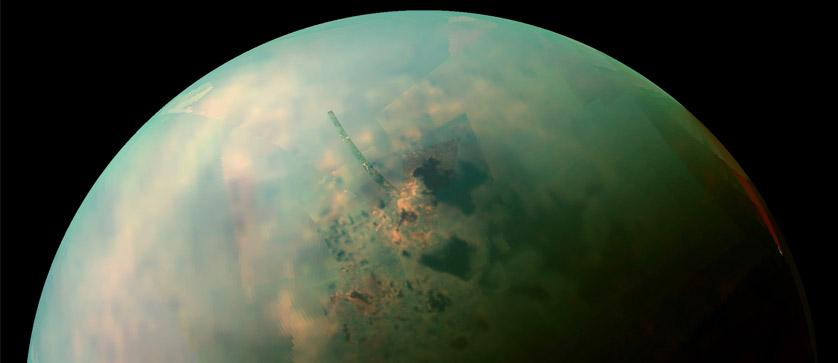NASA: Giant Dust Storms on Saturn's Biggest Moon
NASA has revealed that giant dust storms have been spotted on Saturn's biggest moon, Titan, for the first time. The ground breaking discovery further supports earlier findings that suggest Titan has similarities to earth.
According to the National Aeronautics and Space Administration, data obtained from its Cassini spacecraft shows that huge amounts of dust are being raised by strong gusts of wind that have arisen in powerful methane storms.
Titan is only the third solar system body where NASA has found this phenomenon - the other two being Earth and Mars. Scientists say Titan is similar to the earth in other ways, as it has seasonal changes and shows signs of having stable bodies of liquid on the surface. However, data suggests these are ethane and methane, rather than water.

© NASA / JPL-Caltech / Space Science Institute
Organic dust storm
The discovery of giant dust storms was outlined in a paper published in Nature Geoscience on 24th September. Lead author Sebastien Rodriguez, an astronomer at France's Université Paris Diderot, said scientists already knew about Titan's geology and hydrocarbon cycle.
Now, the active dust cycle has shown further similarities with Earth and Mars. The organic dust is raised from large dune fields around Titan's equator.
Scientists are fascinated by Titan's climate. Hydrocarbon molecules evaporate from its ethane and methane reservoirs, condense into clouds and produce rain.
When the sun crosses Titan's equator (known as the equinox), huge clouds form in what scientists describe as "tropical regions". These bring powerful methane storms and Cassini has observed these during its many flybys of Titan.
New phenomenon
Rodriguez explained that the latest images captured by Cassini weren't methane clouds, as it wouldn't be physically possible for them to form at this time of year. Also, the new phenomenon captured by Cassini is at an altitude of around six miles and methane clouds would be at a higher altitude.
Researchers have also ruled out that the new features were something on Titan's surface, such as icy lava, or frozen methane rain, as these would remain visible for longer than the bright features captured in the latest study, which were visible for varying periods of time, from 11 hours to five weeks.
Instead, the features filmed by Cassini are believed to be thin layers of organic, solid particles, located directly over Titan's equator, so the only reasonable explanation is that they are dust clouds. The organic dust has been formed by sunlight interacting with the methane. Organic molecules have increased in size and have become large enough to fall to Titan's surface.
Rodriguez explained that the wind speeds needed to create such massive dust storms would have to be around five times faster than normal, so it's possible this is a completely new phenomenon.
There is no clear-cut explanation as to why the wind speed has increased to such a degree, although the dunes on Titan's surface, at the region around the equator, change continually.
Joint space project
The current mission around Titan is a joint project between NASA, the European Space Agency and the Italian Space Agency. Images of the dust storms were collected by Cassini's Visual and Infrared Mapping Spectrometer.
This mission is being managed by NASA's Jet Propulsion Laboratory in Pasadena, on behalf of the Science Mission Directorate in Washington.
The Cassini orbiter spacecraft was designed, developed and assembled by the JPL, which also built the radar instrument in collaboration with the Italian Space Agency, team members from the United States and several European partners.
Hydraulic systems
Hydraulics play a vital role in modern space research endeavours. The simplest hydraulics system has three parts: the cylinder, the pump and the fluid. This basis is used to power various aspects of space exploration and travel, as hydraulic systems continue to work in space.
Hydraulics provide the power for important functions, such as thrust vector control for the engines of space craft, controlling rudder and brake speed, and providing propellant control of various valves. Other functions include retracting the external tanks, disconnecting umbilical connections and powering the landing gear deployment.
Other hydraulic system applications are also in use at the International Space Station, playing a key role in the loading boom and also operating some of the Space Station’s manoeuvring capabilities.
Not only do hydraulics work well in space, they are also essential to space missions and play a crucial role in operating space vehicles.
Established for more than 35 years, Phoenix Hydraulics is one of the United Kingdom's largest independent hydraulics companies. We provide specialist hydraulics services and stock the best selection of hydraulic pumps on the market. Please contact us on 01733 234800 for further information.


